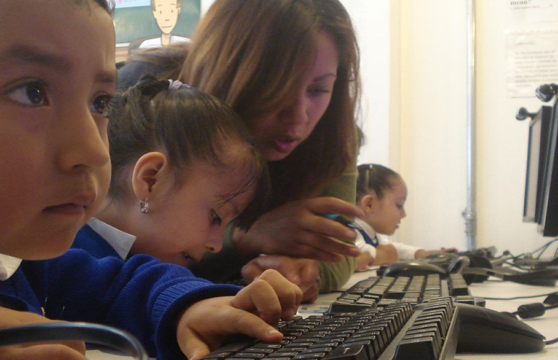
Possible Education Payoffs from ICTs
Economist article discusses the advances in education technology as well as the associated changes and challenges.
The use of technology in education has the potential to improve the teaching and learning experience both inside and outside the classroom. All over the world we are increasingly seeing successful technology-driven innovations. Whether reaching children and young people that have been traditionally excluded from the education system or increasing engagement and performance by allowing more personalized learning and teaching approaches, there is little doubt that technology will continue to play an increasingly critical role in education innovations. But do we have the conditions to allow this transformation to happen at scale? And, more importantly, will technology reach all students and classrooms in an equitable way?
Concerned about slow and gradual improvements in education outcomes in Latin America—and the lack of scalable, equitable technological solutions to these challenges—earlier this year, the Inter-American Dialogue launched a Working Group for innovation and technology in education. Conscious of the fact that technology can be as effective a tool for exacerbating educational inequalities as it is for reducing them, one of the Working Group’s key objectives is to analyze best practices in its use and explore the enabling conditions and considerations that are of critical importance in ensuring that technology is employed appropriately, responsibly and for the greatest benefit.
As part of this effort, we recently spoke with twelve Latin American education startups to learn more about the opportunities and obstacles they are experiencing. We partnered with the Varkey Foundation who helped us identify seven startups that were finalists of the EdTech Next Billion Prize at the 2019 Global Education & Skills Forum in Dubai and five additional ones that had applied. The startups (see list below) are still relatively small and, with one exception, were all founded within the past five years. Nevertheless, they operate in countries across Latin America, from Mexico to Chile, with a variety of business models—business to business (B2B), business to consumers (B2C), business to governments (B2G), or a mix of one or more of these models.
Although it would unfair to claim that this group is representative of education technology (EdTech) startups across the region, it was clear that the leaders we spoke with saw common opportunities and challenges that likely are broadly applicable as they were consistent across countries and business models. These areas of consensus indicate that there are certain realities within the EdTech startup ecosystem in LAC which must be confronted in order for equitable expansion to occur.
In terms of opportunities, the majority of the group agreed that Latin America (and developing markets more broadly) is a young market with little competition. Potential customers abound, from individuals that want to up-skill, learn English or require learning experiences that fit their needs and schedules, to schools, businesses or governments that are undergoing a digital transformation and require access to digital products that can quickly and efficiently reach students or workers to improve performance.
The most consistent challenge mentioned by startups was financing, which came at the top of the list for everyone in the group. These companies have few funding options, and access to capital is very limited, with only a small number of investors and philanthropic capital interested in EdTech. Government and/or foundation grants are scarce, too. In addition, access to early stage capital is often tied to impact, which for small starts ups is an impossible requirement given that rigorous evaluations require scale, deep technical skills and are quite expensive to carry out.
Another frequent challenge was the difficulty of finding skilled talent, meaning people with the right level of technical abilities—and also, often, English language skills. Most agreed that the pool of technically skilled workers is scarce and in high demand; it was difficult to recruit and keep top performers given the competitive market.
Some startups in the group work directly with schools or students and have observed that large-scale implementation and impact can only occur by partnering with the public-school system. Unfortunately, they are hindered in these efforts because, as they see it, national and state governments do not have a clear vision for using technology as a tool for innovation in education. Indeed, several members of the focus group expressed frustration with the fact that some government officials don’t even see the need for EdTech in the classroom. This had all sorts of repercussions and consequences: lack of regulations and policy guidelines, difficulties in creating long-term partnerships and very slow sale cycles, among others.
The sales process is also an arduous challenge for many startups as they seek to increase revenue to a level where they can be financially stable. Most agreed that there is a general lack of awareness about the benefits of digital solutions and skills whether inside or outside the classroom. This leads to limited marketplaces and opportunities for customers to access information and reviews about companies and digital products. Additionally, people in charge of purchasing, particularly in the government, often lack the necessary knowledge to understand these products and negotiate contracts. Given these gaps and bottlenecks, it is unsurprising that many startups also found that teachers, learners and administrators often have a limited capacity to use tech appropriately and in innovative ways to increase learning.
These findings align with a recently published report called Scaling Access and Impact: Realizing the Power of EdTech. The report, commissioned by Omidyar Network, explores the conditions needed to enable an efficient and equitable role for technology within education systems and develops a framework for what an ideal ecosystem should look like.
Why an ecosystem for EdTech? By thinking about the whole system, stakeholders move away from trying to solve isolated issues or problems relevant only to individual actors. Instead, they start addressing the key underlying conditions and drivers necessary for EdTech solutions to succeed everywhere.
The framework consists of four categories:
Each category in turn has four subcategories and they provide a score for each of them (see page 10 and 11 of the report). The framework was applied in the US, China, Indonesia and Chile and provides an interesting comparison between the countries vis-a-vis each other and presents a user-friendly analysis of their strengths and areas for growth, helpful to researchers, policymakers and businesses.
As we were conducting the focus group, it was clear that the challenges discussed by the startup leaders fit within the first three categories of the ecosystem model. We heard that financing options were a critical issue mainly because of their absence. The lack of a clear government strategy around EdTech is behind the difficulties in negotiating government contracts and the inability to scale by accessing the public system. And finally, the capacity to both understand and use technology, at an institutional and individual level, is currently hindering progress to expand technology-driven solutions in education. (Interestingly, we didn’t hear that infrastructure was a problem, but this may be because our inquiry was not exhaustive, and second, this challenge could become apparent as startups scale and start working with the public system more broadly.)
We know there is enormous potential to improve learning using technology. We also think there are many opportunities for social innovators to get involved and create solutions that can be scaled in sustainable ways. This unlikely to happen, however, until the enabling conditions that will allow for this growth to happen are in place—and as our focus group conversations clearly show, we are not quite there yet.
Our hypothesis is that developing the ecosystem necessary for EdTech to scale could bring high returns for learners and all stakeholders involved. For example, creating an environment where innovators are able to get the support and capital they need to grow and test their business model and products in the early phases would allow for necessary feedback mechanisms and rapid adaptation to meet market demands. Likewise, if consumers can understand and compare what is being offered to them and have access to trainings, they are able to make more informed decisions about choosing the product that best meets their learning needs. When the government has a clear vision for EdTech use and how to achieve it, this can serve as a guide for other stakeholders that want to innovate and implement changes that benefit learners in equitable ways.
Creating such an ecosystem will require two things. First, creating or adopting a framework (such as the one developed by Omidyar) to understand key factors in the ecosystem and how they work together, and which provides a clear picture of where things stand and identifies the main factors that hinder progress. The power of such a framework, as with other conceptual frameworks, is that it can be applied across countries and contexts to make distinctions, formulate ideas and prioritize actions. Second, it will be critical to promote an active dialogue between key stakeholders to develop and coordinate actions to improve the ecosystem. Given that the purpose of the framework is to identify relationships and connections between actors and institutions within the EdTech ecosystem, building organic and meaningful exchanges between these stakeholders is an important first step towards improving the operating environment for all.
We are hoping to be part of those efforts with the Working Group and will continue to engage key stakeholders in the region to make this happen.
| Company | Country |
| OXed | Argentina |
| Talk2U | Argentina |
| Whetu | Argentina |
| Analytikus | Mexico |
| Aprendia | Uruguay |
| FractalUp | Peru |
| Laboratoria | Peru |
| Andi | Peru |
| Você Aprende Agora | Brasil |
| Proyecto DANE | Argetina |
| Kuwala | Chile |
| Moi | Chile |
Working Group on Technology and Innovation in Education
Economist article discusses the advances in education technology as well as the associated changes and challenges.
Have investments in technology for Latin American public schools produced the expected results on student learning?
Conference on technology in Latin American schools – takeaways to maximize the use of technology to improve learning.

